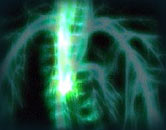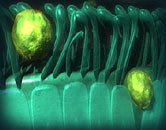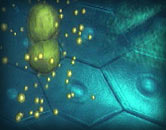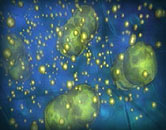
|

|
Killer in the Bloodstream
|

|
|
Even people familiar with meningococcal disease are astonished at
the rapidity with which this rare though deadly illness can ravage
the body. Within hours, patients can go from perfectly healthy to
mortally ill. What makes these microbes so lethal? In this animated
feature, follow the progression of meningococcal bacteria as they
race through the bloodstream, wreaking havoc on a scale few diseases
can match with such lightning speed.—Peter Tyson
 Assaulting the body
Assaulting the body

|

watch video in a new window via:
QuickTime
RealVideo dialup
RealVideo broadband
|
|
Meningococcal bacteria can cause two life-threatening
conditions: meningitis and sepsis.
In meningitis, the bacteria attack the lining around the brain
called the meninges. They breach the meninges to infect the
fluid running into the spinal cord. One clear, early symptom
is a stiff, sore neck. The meninges and brain start to swell,
putting pressure on essential nerves. Fewer than one in 50
victims of meningococcal meningitis will die, but survivors
are often left deaf or with permanent brain damage.
The other type of infection is much more deadly, killing
roughly 20 percent of its victims. It's a severe blood
poisoning called meningococcal sepsis that affects the entire
body. The bacterial toxins rupture blood vessels and can
rapidly shut down vital organs.
|
 Entering the throat
Entering the throat

|

watch video in a new window via:
QuickTime
RealVideo dialup
RealVideo broadband
|
|
Meningococcal bacteria commonly live in the human throat
without causing harm. But sometimes they break through the
throat's lining and enter the bloodstream. The reasons why and
how are only now being unraveled. Damage to the throat from
flu and other infections could be one factor.
|
 Hurtling through the bloodstream
Hurtling through the bloodstream

|

watch video in a new window via:
QuickTime
RealVideo dialup
RealVideo broadband
|
|
Every meningococcal bacterium is surrounded by a slimy outer
coat that contains a poisonous chemical called an endotoxin.
While many bacteria produce endotoxin, the levels produced by
meningococcal bacteria are 100 to 1,000 times greater than
normal.
As the bacteria multiply and move through the bloodstream,
they shed bubbles that contain concentrated amounts of toxin.
These bubbles also act as decoys, confusing the body's immune
system. The endotoxin targets the heart, affecting its ability
to pump and also causes blood vessels throughout the body to
leak. As every vessel starts to hemorrhage, major organs like
the lungs and kidneys are damaged and eventually destroyed.
Two things can stop this runaway infection before the patient
dies: antibiotics like penicillin, and the patient's own
immune system.
|
 Attacked by antibiotics
Attacked by antibiotics

|

watch video in a new window via:
QuickTime
RealVideo dialup
RealVideo broadband
|
|
As soon as doctors suspect meningococcal disease, patients are
given a large dose of antibiotic, usually penicillin.
Penicillin flowing through the bloodstream rapidly kills the
bacteria. But it cannot penetrate the bubbles that contain the
endotoxin. In fact, as the bacteria are killed, they release
even more toxin. It takes up to two days for the poison to be
cleared from the body and the siege to end.
|
 Killing tissue
Killing tissue

|

watch video in a new window via:
QuickTime
RealVideo dialup
RealVideo broadband
|
|
As soon as the bacteria entered the bloodstream, unleashing
the poisonous endotoxin, the body began responding on its own.
White blood cells, the hunter-killers of the immune system,
locked onto the bacteria, engulfing them and coming into
contact with the endotoxin.
The poison causes the white cells to release chemicals that
make the blood vessel walls sticky. The white cells then
become trapped on the walls, leaving a trail of damage.
Gradually the lining of the blood vessels is stripped away.
And as the damage increases, the vessel walls break up and
pieces fall off. The blood's repair cells, called platelets,
rush to plug up the damaged areas.
Dangerous clots begin to form. The proteins that normally
prevent clotting have all been destroyed. Within minutes the
small blood vessels of the body are completely blocked. The
damaged blood vessels disintegrate, and blood and other fluids
hemorrhage into the surrounding tissue. It is this cascade of
events that causes the distinctive rash that appears beneath
the skin and kills tissue throughout the body.
|
|

|

Killer Disease homepage
|

